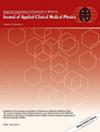Evaluating the Ethos automated planning system for spatially fractionated radiotherapy
Abstract
Purpose
Lattice radiotherapy (LRT), a form of spatially fractionated radiation therapy (SFRT), has emerged as a promising approach for treating massive tumors. By delivering high-dose regions within the tumor while sparing surrounding healthy tissue, LRT offers distinct advantages over conventional radiotherapy. Recent advancements in treatment planning systems (TPS), particularly the integration of intelligent optimization engines (IOEs) with automated planning capabilities, have the potential to further refine and expand the clinical utility of LRT. This study aimed to comparatively evaluate the planning quality and clinical feasibility of lattice SFRT treatment plans generated using the Ethos planning system, equipped with an IOE and O-ring linear accelerator, versus the Eclipse planning system paired with a conventional C-arm TrueBeam linac, in patients with stage III non-small cell lung cancer (NSCLC).
Methods
Twenty retrospective stage III NSCLC cases (GTV > 200 cc) with available PET-CT imaging were selected. A total of 40 plans (20 Eclipse, 20 Ethos) were compared, incorporating lattice spheres (1 cm diameter, 2 cm spacing between spheres) placed in the tumor, FDG-PET/CT-informed intratumoral heterogeneity, prioritizing viable perinecrotic subregions while avoiding critical OARs. Plans aimed to deliver 15 Gy to lattice spheres, limit Valley (PTV minus spheres) doses to 2 Gy, and restrict doses to organs at risk (OARs) to ≤ 3 Gy. Dose conformity, OAR sparing, dose gradient parameters (PEDR, PVDR), planning time, and deliverability, which was evaluated using ArcCheck, EPID gamma analysis, and MLC log-file verification.
Results
Ethos demonstrated statistically significant improvements compared to Eclipse in lattice sphere mean dose (17.2 Gy vs. 15.83 Gy, p < 0.001), V15 Gy coverage (98.2 % vs. 91.74 %, p < 0.001), and dose gradient metrics (PEDR: 6.42 vs. 5.80; PVDR: 3.70 vs. 3.29; both p < 0.001, and VPDR: 0.131 vs. 0.135; PVDRDVH: 7.62 vs. 7.41). For the valley target, Ethos plans demonstrated a lower mean dose (Dmean: 4.72 Gy vs. 4.91 Gy, p = 0.064), although not statistically significant, and achieved significantly improved dose gradient at V7.5 Gy (14.5% vs. 16.35%, p = 0.019), V5Gy (30.77% vs. 34.84%, p = 0.006), and V2Gy (99.77% vs. 97.79%, p < 0.001) compared to Eclipse. Ethos achieved significantly better OAR sparing, particularly for the bronchial tree, heart, spinal cord, esophagus, and great vessels (all p < 0.01). Furthermore, Ethos substantially reduced planning time (36.55 vs. 95.96 min, p < 0.001). Both planning systems achieved high gamma passing rates (> 95%), confirming the accuracy and deliverability of the treatment plans.
Conclusion
The Ethos automated treatment planning demonstrated superior lattice dose conformity, enhanced OAR sparing, and significantly faster optimization compared to Eclipse. This automated optimization capability highlights the potential of Ethos for efficient and effective lattice radiotherapy in managing massive NSCLC tumors.


 求助内容:
求助内容: 应助结果提醒方式:
应助结果提醒方式:


